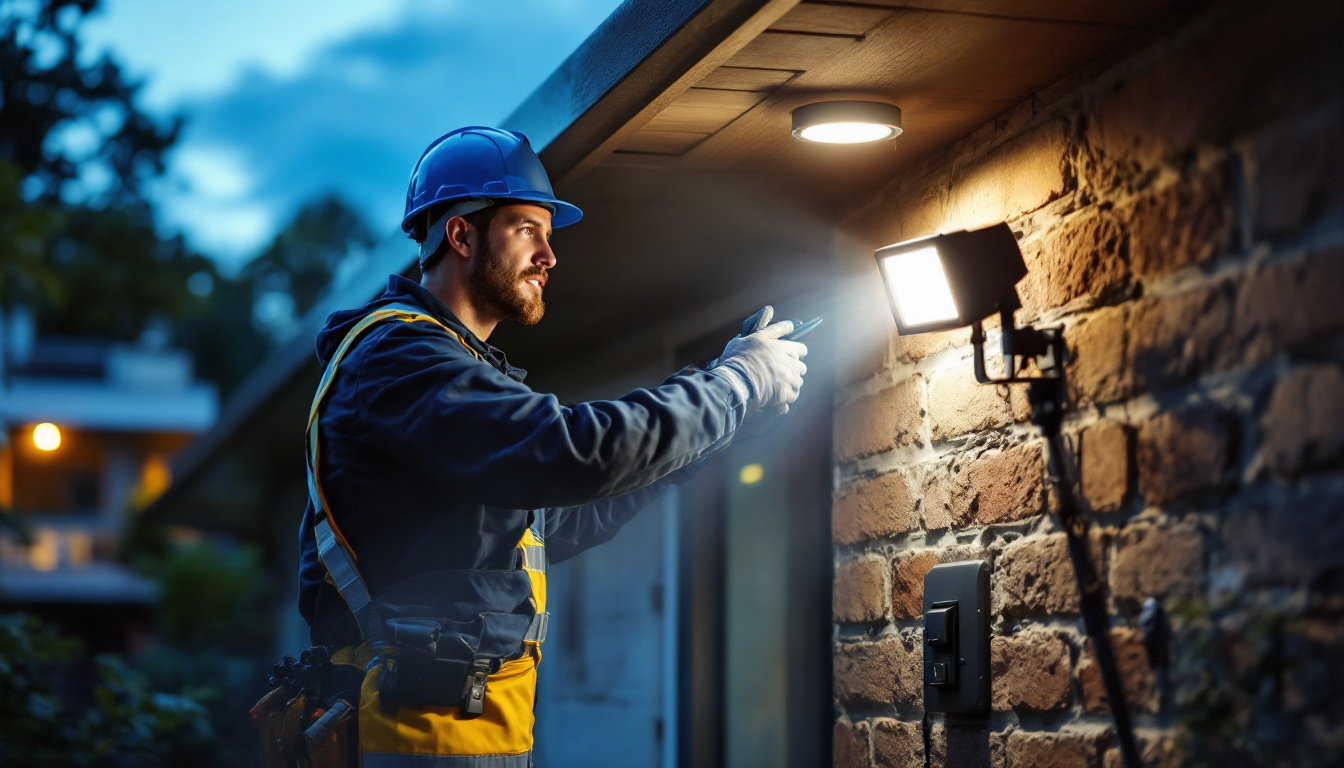
LED outdoor flood lights have transformed the landscape of outdoor lighting, offering energy efficiency and longevity that traditional lighting options cannot match. These lights are designed to illuminate large areas, making them ideal for various applications, including parking lots, sports fields, and building exteriors. As lighting contractors, understanding the technology, benefits, and compliance requirements of LED flood lights is crucial for successful installations.
One of the most significant advantages of LED flood lights is their energy efficiency. They consume significantly less power compared to incandescent or halogen lights, which translates to lower electricity bills for clients. Additionally, LED lights have a longer lifespan, often lasting up to 25,000 hours or more, reducing the frequency of replacements and maintenance.
Moreover, LED technology offers superior brightness and color rendering capabilities, allowing for better visibility and aesthetics in outdoor spaces. With advancements in LED technology, these lights can also be dimmed and controlled remotely, providing added flexibility for various applications. This adaptability is particularly beneficial for venues that host events at different times, as the lighting can be adjusted to create the perfect ambiance, whether for a bright sports game or a subdued evening gathering.
Furthermore, the durability of LED flood lights should not be overlooked. Unlike traditional bulbs that can be fragile, many LED options are designed to withstand harsh weather conditions, including rain, snow, and extreme temperatures. This resilience makes them a reliable choice for outdoor installations, ensuring that they continue to perform optimally regardless of environmental challenges. Additionally, many LED flood lights come with features such as motion sensors and timers, enhancing security and energy savings by ensuring lights are only on when needed.
When working with LED outdoor flood lights, compliance with local and national regulations is essential. Various standards govern the installation and usage of outdoor lighting, including energy efficiency guidelines and safety regulations. Familiarity with these standards not only ensures legal compliance but also enhances the credibility of the contractor.
Lighting contractors should stay updated on the latest regulations, such as those set by the Department of Energy (DOE) and the International Dark-Sky Association (IDA). These organizations provide guidelines that help minimize light pollution and promote energy-efficient lighting solutions. Additionally, understanding the impact of light pollution on wildlife and human health is becoming increasingly important. By adhering to these guidelines, contractors can contribute to creating environmentally friendly spaces that respect both nature and community well-being.
Moreover, many municipalities are now implementing stricter codes regarding outdoor lighting, which can include restrictions on brightness levels and requirements for shielding to prevent light trespass. Being proactive in understanding these regulations not only aids in compliance but also positions contractors as knowledgeable professionals in the field, capable of providing clients with solutions that are both effective and responsible. This knowledge can also lead to opportunities for contractors to educate their clients on the benefits of sustainable lighting practices, fostering a partnership based on trust and shared values in energy conservation.
Proper installation of LED flood lights is critical to achieving optimal performance and compliance. Lighting contractors must consider several factors, including the placement of fixtures, wiring, and mounting options. Each of these elements plays a vital role in ensuring that the lights function effectively and meet safety standards.
The placement of LED flood lights can significantly impact their effectiveness. Contractors should evaluate the area to be illuminated and determine the best locations for fixture installation. Factors such as the height of the fixtures, the angle of illumination, and potential obstructions should be carefully considered.
For instance, mounting lights too low may result in inadequate coverage, while positioning them too high could lead to light pollution and waste. A well-planned layout will ensure that the lights serve their intended purpose while adhering to compliance regulations. Furthermore, it’s beneficial to conduct a lighting simulation or use photometric analysis tools to visualize how the light will distribute across the area. This can help in making informed decisions about fixture placement, ensuring that dark spots are minimized and that the overall illumination is uniform and effective.
Electrical wiring is another critical aspect of LED flood light installation. Contractors must ensure that the wiring used is appropriate for the specific application and complies with local electrical codes. This includes selecting the right gauge of wire, ensuring proper grounding, and using weather-resistant materials for outdoor installations.
Additionally, it is essential to consider the power supply and circuit load. Overloading circuits can lead to failures and pose safety hazards. Proper calculations and planning can help avoid these issues and ensure a safe installation. Moreover, implementing surge protection devices can safeguard the lighting system from voltage spikes, which are common in outdoor environments. This proactive measure not only extends the lifespan of the LED fixtures but also enhances overall reliability, making the system more resilient against electrical disturbances. Regular maintenance checks on the wiring and connections can further ensure long-term performance and safety, allowing for timely identification of any wear or potential issues that may arise over time.
As energy efficiency becomes increasingly important, contractors must emphasize the sustainability benefits of LED flood lights to clients. Not only do these lights consume less energy, but they also contribute to reducing carbon footprints. By promoting energy-efficient solutions, contractors can position themselves as environmentally responsible professionals. Furthermore, the longevity of LED technology means that fewer fixtures end up in landfills, aligning with the growing consumer demand for eco-friendly products. This commitment to sustainability can enhance a contractor’s reputation and appeal to a broader audience that prioritizes green practices.
Many regions offer incentives and rebates for installing energy-efficient lighting solutions, including LED flood lights. Contractors should be aware of these programs and inform clients about potential savings. This not only helps clients reduce upfront costs but also encourages them to invest in sustainable lighting solutions. Additionally, some utility companies provide financial assistance or discounts for energy-efficient upgrades, making it even more appealing for clients to make the switch. By staying informed about local and federal initiatives, contractors can serve as valuable resources, guiding clients through the process of maximizing their savings while enhancing their property’s energy efficiency.
By leveraging these incentives, contractors can enhance their service offerings and attract more clients who are interested in energy-efficient upgrades. This proactive approach not only fosters a sense of trust but also positions contractors as knowledgeable partners in their clients’ sustainability journeys. As more homeowners and businesses seek to align their practices with environmental stewardship, contractors who can navigate these financial benefits will find themselves at a competitive advantage.
While the initial investment in LED flood lights may be higher than traditional lighting options, the long-term cost savings are significant. The reduced energy consumption and extended lifespan of LED fixtures lead to lower maintenance and replacement costs over time. Contractors should communicate these benefits to clients to help them understand the value of investing in quality lighting solutions. Moreover, the efficiency of LED lights means that they generate less heat, which can contribute to lower cooling costs in warmer months. This added layer of savings can be particularly appealing to clients looking to optimize their overall energy expenditures.
In addition to financial savings, the superior quality of light produced by LED flood lights enhances visibility and safety, which is crucial for outdoor spaces and commercial properties. Contractors can highlight how improved lighting can deter crime and increase the usability of outdoor areas during nighttime hours. By presenting a comprehensive view of the benefits—financial, environmental, and safety-related—contractors can effectively persuade clients to choose LED solutions over traditional options, ensuring that they are making a wise investment for both their wallets and the planet.
Beyond functionality, the aesthetic appeal of outdoor lighting plays a crucial role in design. LED flood lights come in various styles and finishes, allowing contractors to select options that complement the architecture and landscape of the installation site.
Choosing the right color temperature and brightness is essential for achieving the desired ambiance. LED flood lights are available in a range of color temperatures, from warm white to cool daylight. Contractors should consider the purpose of the lighting and the preferences of the client when selecting these parameters.
For example, warm white light may create a cozy atmosphere for residential settings, while cooler temperatures may be more suitable for commercial applications. Understanding these nuances can help contractors deliver tailored lighting solutions that meet client expectations.
With the rise of smart home technology, integrating smart controls into LED flood light installations is becoming increasingly popular. Contractors should explore options for remote control, scheduling, and automation to enhance the functionality of outdoor lighting systems.
Smart technology not only improves convenience for users but also allows for energy savings through automated scheduling and dimming features. By offering these advanced solutions, contractors can differentiate themselves in a competitive market and provide added value to clients.
Even with the long lifespan of LED flood lights, regular maintenance is essential to ensure optimal performance. Contractors should educate clients on the importance of routine checks and provide guidance on troubleshooting common issues that may arise.
Regular inspections can help identify potential problems before they escalate. Contractors should recommend a maintenance schedule that includes checking for loose connections, cleaning fixtures, and assessing the overall condition of the lighting system. This proactive approach can extend the life of the fixtures and maintain consistent performance.
Additionally, contractors should inform clients about the signs of malfunction, such as flickering lights or inconsistent brightness, and provide guidance on when to seek professional assistance.
Contractors should be prepared to troubleshoot common issues that clients may encounter with LED flood lights. This includes addressing problems related to power supply, wiring, and fixture malfunctions. Having a clear understanding of these issues will enable contractors to provide timely solutions and maintain client satisfaction.
Furthermore, offering maintenance services can create an ongoing relationship with clients, leading to repeat business and referrals.
LED outdoor flood lights represent a significant advancement in lighting technology, offering numerous benefits in terms of energy efficiency, longevity, and aesthetics. For lighting contractors, understanding the compliance requirements, installation considerations, and maintenance practices is essential for delivering high-quality services to clients.
By staying informed about the latest trends and regulations, contractors can position themselves as experts in the field and provide valuable solutions that meet the evolving needs of their clients. Emphasizing energy efficiency, sustainability, and innovative technology will not only enhance client satisfaction but also contribute to the overall success of the lighting business.
Ready to elevate your lighting projects with the best LED outdoor flood lights on the market? Look no further than LumenWholesale, where we provide contractors like you with top-quality, spec-grade lighting products at unbeatable wholesale prices. Say goodbye to local distributor markups and hello to superior lighting products that meet the highest industry standards. With LumenWholesale, you can enjoy the convenience of bulk buying with free shipping, ensuring you get the premium lighting you need at the best value — all without hidden fees or compromises. Don’t miss out on the perfect blend of quality, affordability, and convenience. Wholesale Lighting at the Best Value is just a click away!

Discover why lighting contractors should prioritize LED lighting with battery integration.

Discover the innovative strategies lighting contractors use to integrate 2×2 LED flat panels into modern spaces.

Discover how Hi Lite is transforming the lighting industry by enhancing efficiency for contractors.

Discover how light dimmers for LED lights can enhance energy efficiency and cost savings for lighting contractors.